VOL.50
March 2019


Trip ____ Boramae Safety Experience Center
Learning Hub for
Anti-disaster Training
Aimed at Promoting
Safety Awareness and Compliance
Boramae Safety Experience Center
So far, a number of issues have been raised on complacency about safety, followed by preventive measures for safety accidents, but there have been a series of major tragic disasters consistently occurring around us. Major disasters in Korea, such as the Seongsu Bridge collapse and the Sampoong Department Store collapse, are good indicators of how complacent and numb we have been about safety. This Issue introduces to you a training hub where you can learn to respond to disasters occurring anywhere and anytime in a quick and safe manner.
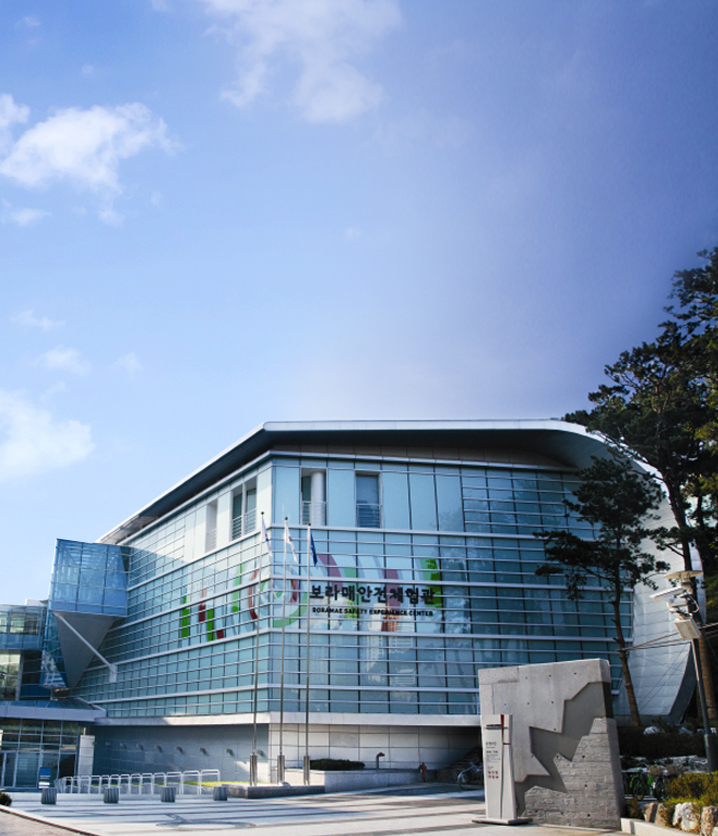
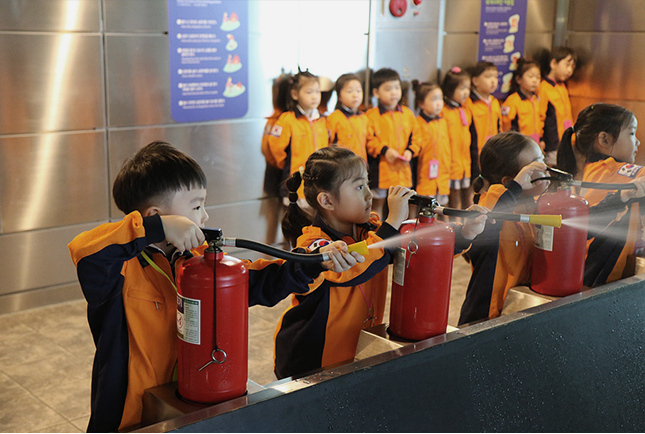
Fire Escape Experience Hall where participants can learn how to use an extinguisher and have a hands-on experience of putting out a fire
Virtual Disaster Experience Center with Real-life Setting
Disasters arising from various environmental and social changes, such as climate change and increasing numbers of high-rise and large-sized buildings, inflict enormous human and property losses. It is important to establish measures to prevent safety accidents, and also to be fully aware of how to implement those measures. The Boramae Safety Experience Center is a place where you can learn how to respond to accidents through hands-on experience.
The Boramae Safety Experience Center, operated by the Seoul Metropolitan Fire and Disaster Management Headquarters, was opened on May 25, 2010. The center operates on an advance reservation basis, and the average number of daily visitors is over 500. The center has four disaster experience halls, dedicated to typhoons, earthquakes, fire accidents, and traffic accidents, and visitors are given opportunities to learn basic emergency treatment, including CPR. Also, its professional experience hall provides training sessions on the operating principles and methods of various fire facilities. These VR training sessions are based on hands-on experience and are taught by current firefighters with extensive firefighting experience. These experience sessions are conducted three times a day for groups of 20 people. First, we visited the Fire Escape Experience Hall. This hall is where visitors can learn to respond to fires occurring in our everyday lives. If a fire occurs, what should you do first? You might reasonably think that the first thing to do is to report to 119; but the answer is to shout out “Fire!” so that nearby people are alerted to the situation in time, and the next thing to do is to report to 119. Participants took part in various hands-on sessions, for example, putting out a fire that occurred in a virtual office setting using an extinguisher or attempting to escape from an enclosed space on fire one by one while covering noses with their arms.
Boramae Safety Experience Center
A hands-on experience center dedicated to disasters and safety, where citizens can learn how to respond to various disastrous situations, including natural and artificial disasters, through hands-on experience
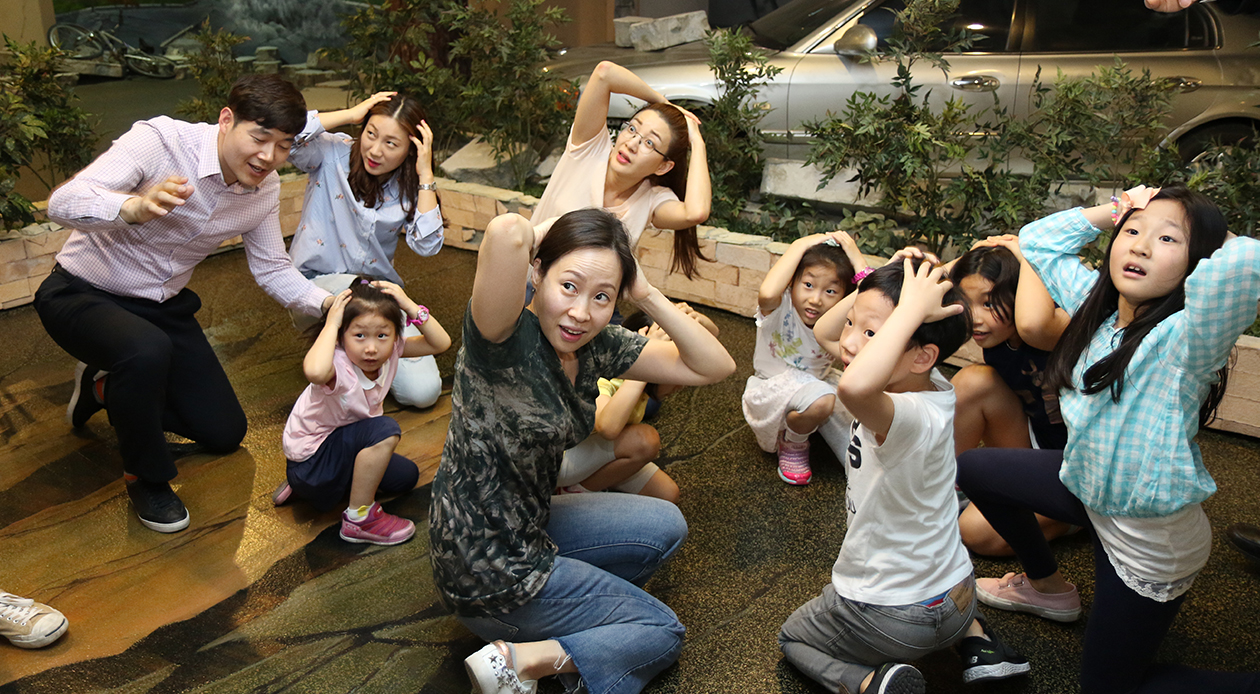
Outdoor Earthquake Experience Program where participants can learn how to respond when a 5.0 magnitude earthquake occurs (outdoors) through hands-on experience
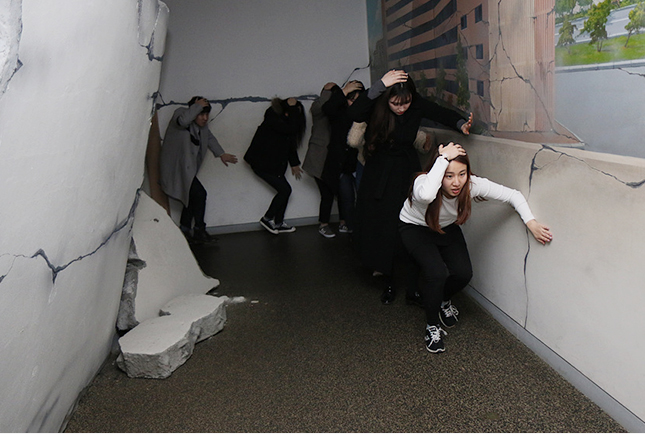
Indoor Earthquake Experience Program where participants can learn how to escape from a collapsing building when a 7.0 magnitude earthquake occurs (indoors) through hands-on experience
Appropriate Response to Disasters and Its Significance
Gyeongju was hit hard by a 5.8 magnitude earthquake on September 12, 2016, and subsequently a 5.4 magnitude earthquake struck Pohang on November 15, 2017. It was the second largest earthquake since the beginning of instrumental earthquake monitoring in 1978, and this clearly demonstrates that the Korean Peninsula is no longer safe from seismic activity. Now, when an earthquake occurs, what should you do first? The Earthquake Experience Hall is a place set as an indoor kitchen, where visitors can have a hands-on experience of responding to a 7.0 magnitude earthquake. They attempt to hide under tables with their heads and necks down and subsequently escape from the place. When you hear about an earthquake’s magnitude, for example, 7.0, it might still be difficult to perceive how powerful it is, but it is completely different when you experience it first-hand. While exposed to such brutally powerful seismic waves, participants’ awareness of earthquakes is naturally heightened. The next session was conducted outdoors, and participants learned to escape on the street while staying away from a target building. This time, they had to look up toward the top of the building because debris, such as window glass, might fall off the building during an earthquake.
Next, we moved on to the Typhoon Experience Hall. Typhoons are unwelcome guests that come and stay every summer, causing human and personal losses. Here, visitors can experience first-hand the power of wind at a maximum speed of 30 m/s and further a typhoon accompanied by strong wind and rainfall at a rate of 300 mm/h. This short but intense experience allows participants to make sense of the power of typhoons and learn to escape from them. Elementary school students are only allowed to participate in the strong wind experience program.
In the Traffic Accident Experience Hall, visitors can participate in two experience programs: bus accident experience and subway fire accident experience. In the bus accident experience program, participants will learn that passengers should fasten their seatbelts, and the driver should drive safely to prevent any traffic accidents. In the subway fire accident experience program, participants can learn how to respond to subway accidents through hands-on experience. A firefighter in charge of the program explained that the reason why the Daegu subway fire accident was so fatal was because the subway driver escaped with the key, leaving all the doors shut and locked. When a subway fire occurs, it is important to cover your nose with your arm so as not to directly inhale smoke, and to move calmly even in the dark. Next, the participants learned how to open subway doors when they were locked and subsequently practiced how to escape from the fire site in an orderly manner. This experience felt more realistic because they had to make their way out through real smoke in the dark.
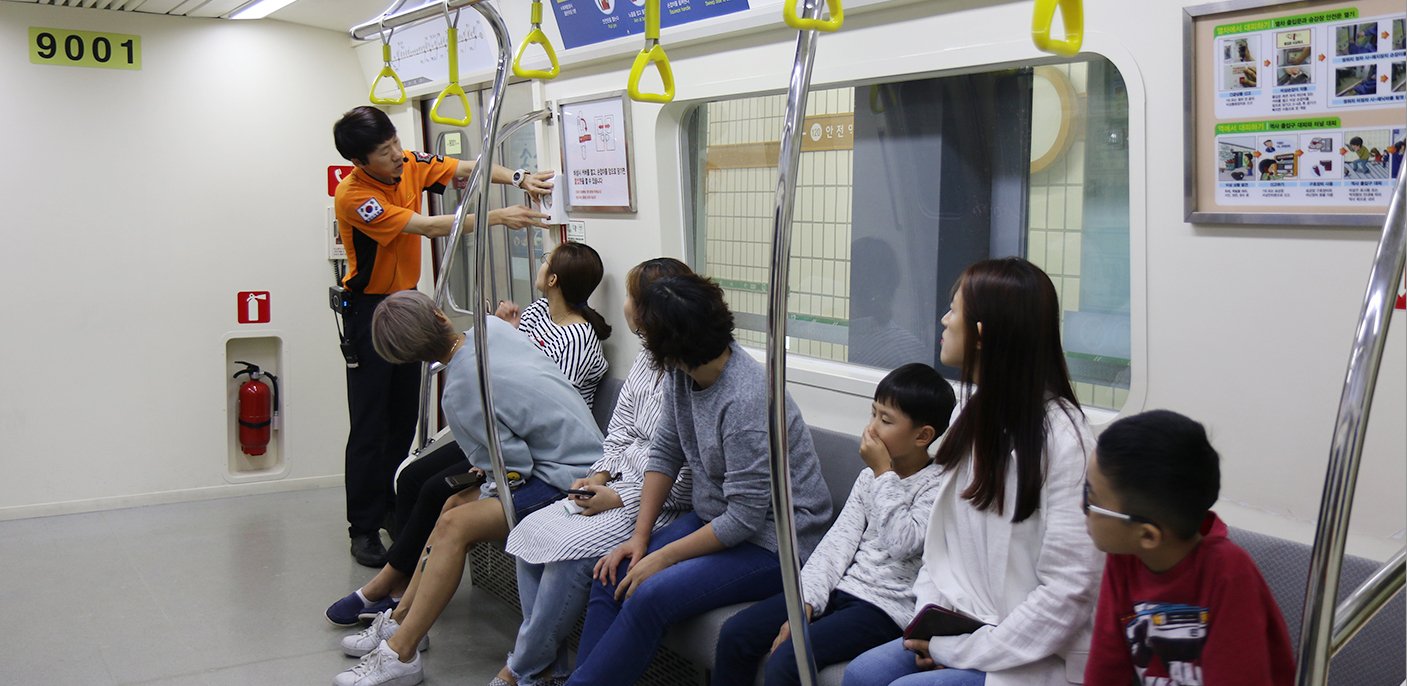
Citizens attending training sessions on how to escape from a subway fire, instructed by a current firefighter with extensive firefighting experience
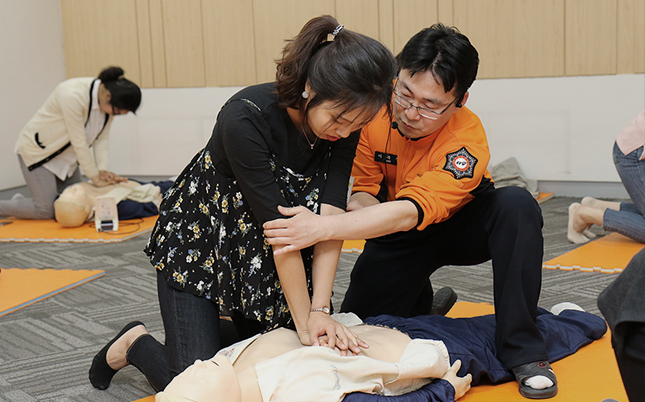
Professional Experience Program where participants can learn about basic emergency treatments, including CPR, from a current firefighter
Learning Hub for Anti-disaster Training, Saving Myself and My Neighbors
The Professional Experience Hall provides a 60-minute program composed of emergency treatment training and hands-on experience on fire facilities. Unfortunately, the CPR hands-on training as part of the emergency treatment training is only allowed for adults. Participants can learn how to perform CPR and use an AED properly. Many people are familiar with CPR because the method is frequently featured in medical TV programs or movies. Most of them, however, have wrong information about how to perform it in practice. Often times, people mistakenly think that the treatment is all about simple chest compressions using their arms and hands, but such false knowledge could cause complications, possibly leading to tragic consequences.
A firefighter in charge of the program first demonstrated how to perform CPR. When a stranger collapses in front of you, you might feel a little hesitant to perform artificial respiration, but the proper execution of CPR alone can increase the likelihood of the person surviving. Instead of thinking to yourself, “Such a thing can’t happen to me, right?” let’s learn first aid treatment to respond to emergencies that can occur anywhere and anytime and thus protect the safety of your family and neighbors.
Again, accidents and disasters, threatening our safety, can occur anywhere and anytime. If they are unavoidable, damage mitigation measures should be considered and implemented along with countermeasures. The Boramae Safety Experience Center is a place where citizens from Seoul and the metropolitan area can learn about safety through hands-on experience, for example, regarding how to respond to each type of accident. These activities will significantly help mitigate the risk of accidents in real-life situations. We hope that the Boramae Safety Experience Center will continue to serve as a learning hub for anti-disaster training, thereby promoting public awareness of safety.



